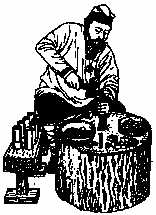



















| |

Mint
House
History.
The kingdom of Nepal, a neightbore country of Tibet, owned its prosperity
to its historical position on one of the easiest trade routes between central
Tibet and India. Nepal made full use of this, and a trading community was set up
in Lhasa during the 16 Th century. During
this time the Nepalese coins became the accepted currency medium in
Tibet.
Shortly
after 1720 the Nepalese government began stricking specific coins for use in
Tibet. These coins had a lower silver content than those struck for use in
Nepal. The Tibetan government paid for this coins an equal weight in high
quality silver bullion.
The
seeds of discord between Nepal and Tibet were sown during the first half of the
18 th century, when the Nepalese again debased the amount of silver in the
Tibetan coins.
Around
1763 the Tibetans struck their own coins for the first time in history. The
number of coins struck in the beginning must have been very small. Larger
quantities of coins were struck by the Tibetan mint in approx. 1791. The Tibetan
mint continued to strike coins until 1953.

Mint House
The Ga-den Thangka must have been minted
in different places, in some cases at least unofficially. Untill now not
all places of minting are exactly known.
-
KM Y
13 : ( ca. 1850)
-
KM Y 13.1
: Dodpal mint (ca.1875)
-
KM Y 13.2 : Tip Arsenal mint
(ca. 1895-1901)
-
KM Y
13.3 : (ca. 1900)
-
KM Y
13.4 : (ca. 1901-1906)
-
KM Y
13.5 : (ca. 1905)
-
KM Y 13.6 :
Dode mint (ca. 1906-1912)
-
KM Y
13.7 : (ca. 1912-1923)
-
KM Y
13.8 : (ca. 1914-1923)
-
KM Y 13.9 : Ser-Khang mint
(ca. 1921)
-
KM Y 13.10 :
Dode mint (1929-1930)
-
KM Y
14 : (ca. 1909-1910)
-
KM Y 31 : Tapchi mint
(1947)

|
 Hans Sanders (NL)
Hans Sanders (NL)